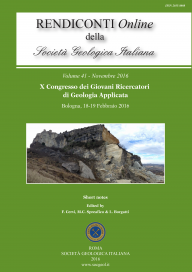
3D point cloud analysis for surface roughness measurement: application of UAV photogrammetry
Giovanni Mastrorocco (a), Riccardo Salvini (a), Giuseppe Esposito G. (a) & Marcello Seddaiu (a)
(a) Department of Physics, Earth and Environmental Sciences and Centre of Geotechnologies, University of Siena, San Giovanni Valdarno, Arezzo, Italy E-mail: mastrorocco2@student.unisi.it
Volume: 41/2016
Pages: 313-316
Abstract
This paper describes the application of close-range digital photogrammetry through Unmanned Aerial Vehicle (UAV) for rock discontinuity roughness determination. This was possible thanks to the creation of a georeferenced point cloud characterised by 3D information useful for rock mass study. In particular, UAV systems allows producing dense point clouds (with high spatial resolution), suitable to describe the rock surfaces and allowing the surveying of inaccessible outcrops. In fact, the occlusion phenomenon was minimized by means of different acquisition angles. In this context, the computation of the Joint Roughness Coefficient (JRC) was carried out picking several points within the cloud and obtaining rock profiles of the maximum asperity amplitude. Furthermore, we present in the manuscript a rapid and preliminary estimation of the whole rock slope roughness using the freeware CloudCompare code. A 3D roughness model was generated. The JRC results, both manually measured and automatically computed by the code, are comparable. The reliability of the values was confirmed by direct engineering-geological surveys where the surface roughness was calculated using the traditional method of visual comparison to Barton's reference roughness profiles. The paper aims to demonstrate how data derived from UAV processing are, nowadays, so dense and accurate to be able to provide adequate measurements of discontinuity roughness even transcending the problem of the JRC scale effect.
Keywords
Get Full Text